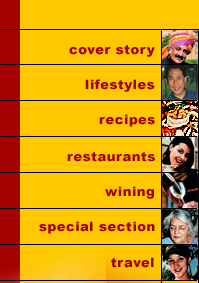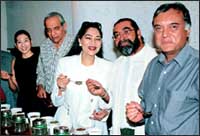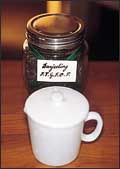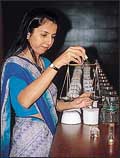


 High On Tea
High On Tea
SIMI GAREWAL, the beautiful actress and chat show hostess, attends a tea-tasting ceremony by celebrity ad. film-maker and tea connoisseur PRAHLAD KAKKAR. |
|
WHEN Prahlad Kakkar invited me to his Tea Centre at Resham Bhavan, Churchgate, to "enjoy a few Darjeelings, some Assams and Nilgiris, and share a few laughs", I almost declined. I am strictly a mint tea drinker. First thing in the morning, I must have my cup of pudhina chai. It's a great pick-me-up. I don't require pick-me-ups, but I like the taste of fresh mint. I have a weakness for it. Nights, I drink Earl Grey. This has been a habit for ever since I can remember. I was reluctant to get introduced to teas from the gardens and estates of Darjeeling, Assam and Nilgiri. But Prahlad is charming. And persuasive. I went. And I'm glad I did, because he had put together an eclectic table of tea-drinkers for the occasion. I also found his Tea Centre was a quaint little place. Like one of Wodehouse's London cafes where high teas are spiced with gossip, and where a pianist tinkles away in the background.
The others got there before me. There was Raj Singh Dungarpur, looking like he had come out of a stormy Board of Control for Cricket in India meeting, when all he had done was cross the road from the Cricket Club of India to be Prahlad's guinea pig. In him, I found a kindred soul! Raj Singh is a mint tea drinker. For 30 years, he has only been drinking that at the CCI. "You get the ultimate cup there," he declared authoritatively. I believed him. Anybody who gets up at 5.30 a.m. and takes a walk to reach the CCI at 7, by which time they serve the first cup of mint tea, must know his cuppa. But, I still think, my home tea's better! And Zafar Hai, who I know from the film world, I discovered he drinks a "Runglee Rungliot" tea from Darjeeling. He fell in love with it while shooting a film in the verdant tea gardens of that hill-station. Zafar religiously has six cups of Runglee Rungliot every day, two-and-half of these when he wakes up. "You must try it," he urged me, "it's a different kind of Darjeeling tea. It's got aroma, but it's light." I told him I hadn't heard of this tea before. Getting Runglee Rungliot was difficult here, he admitted, but happily he had discovered a new source in Prahlad's Tea Centre now.
The most exotic among us was Satoko Mitsui, a delicate Japanese girl, who turned out to be a connoisseur of tea and an expert at the ceremonial Japanese tea ceremony. Prahlad said she was the daughter of the former Japanese prime minister, Morihiro Hosokawa, and a descendant of some legendary Samurai swordsman. He recognised the warrior blood in her, he claimed. Satoko expressed a fascination for Indian teas and said she spent much of her time learning about them at the Tea Centre. She planned to repay Prahlad by introducing the Japanese tea ceremony here. "You must come," she told me, "it's a great form of meditation." And there was another foreigner, John Baxter, an Australian writer of film directors' biographies, and a confirmed tea addict. He had already written about Woody Allen, Steven Spielberg, George Lucas and Robert de Niro. Research on Salman Rushdie, his next subject, had brought him to India. His wife, Marie Dominique Montel, who had accompanied him, was a film producer. She was making a film on Australian convicts in countries with French connections.
Her work had taken her to the notorious Kala Pani Prison at Andaman & Nicobar Islands. Where she bumped into Prahlad. I was amazed to learn that Prahlad is a certified scuba diving instructor and is looking at conducting classes in the coral waters off the islands. Look at the man's zest for life! Ad. films, tea, and now this. When I travelled to Thailand in the Seventies for the premiere of Siddhartha, I attended a Japanese tea ceremony. All I can remember of it was that it was a ritual. In contrast, Prahlad's is quite simple. His tea room has long wooden tables in the centre and stainless steel spitoons on the side. The tea leaves, some 16, 17 varieties sourced directly from the gardens, are kept in glass bottles on the tables. The teas are brewed in small white ceramic pots with lids. Brewing time is three minutes. Prahlad times this with an old hour-glass. He uses an older silver weighing scale to measure out the tea. Two grams per pot, not a leaf more. Brewing is achieved by pouring boiling hot water into each pot. There's no stove here with a kettle bubbling away. You know your tea is ready when the sands run out in the hour glass. The pot is then turned on its side into a slightly larger cup. While the liquor drains out, the mulch (residue) remains. You may have your tea, but please don't ask for milk and sugar!
Before sipping the tea, professional tea-tasters examine the mulch. They look for consistency, sponginess, aroma and colour. Then they examine the colour of the liquor. It should be transparent, not muddy and dull, have brightness, a good nose and ligering aroma. And, finally, they taste the tea. You have to roll it in your mouth like you might do a good wine, before spitting it out. Prahlad demonstrated, noisily slurping the tea, then gargling the way I have seen cabbies do at roadside tea-stalls. Noticing my embarrassment, he said reassuringly, "By doing this, I am aerating the tea, mixing it with air, and releasing its flavours." He spat it accurately into a spitoon, then called the class to order to listen to his findings. "This Darjeeling FTGFOP (that's Fine Tippy Golden Flowery Orange Pekoe!) is distinctive for its peachy fragrant taste. This one's classy Darjeeling, it has an exquisite bouquet. And it's light, bright, brisk and golden." He moved down the table and onto the next tea that his assistant, Shaheen Adenwalla, had brewed for us. The same procedure, then: "This one, Assam CTCBOP (Cut, Tear and Curled Broken Orange Pekoe), is full-bodied and rounded, and it has elements of spice.
Look at its bright colour, notice the robust texture." And a Nilgiri after that. "This TGFOP is a distinctive leafy tea from the blue mountains. Savour its golden orange colour, velvety texture, notice the special fragrance, taste the flavours of the misty mountains. It's got a slight bite, sharp and acidic." The characteristics of a good tea, he concluded, were the pre-taste, main taste and after-taste. A combination of all made a good tea. What you are left with is the lingering after-taste. If that is off, you will not remember the pre-taste. Prahlad Kakkar might have been an oenophile giving us lessons in wine appreciation. But after 12 teas, we had tasted one too many. Zafar retired first. "They're so strong in aroma, you can get dizzy," he said. Raj Singh was the next to go. Apologetically, he said: "Outside the CCI, I never have tea at all, not even at home. And never after sunset. It's psychological. Chinese tea with dinner? Why, yes. But that's different." Satoka could have carried on. "I've learnt about four or five Darjeeling and Assam teas," she said, "but there's so much more." And John Baxter proved to be a revelation. "Aussies only drink tea, it's our national drink," he said. "But we like biscuits with our tea. Something to dunk in and bite!" Prahlad took the hint and herded us out of the tea room and into the restaurant, where a high tea awaited. There was tea by the cuppa. The hot, strong and milky, home brew. And biscuits, Indian snacks, french fries with various sauces, and sandwiches. Prahlad, I noticed, was drinking from a pot. "This is Kullad Ki Chai," he said, "ordinary Assam CTC tea boiled in milk and sweeted with jaggery. The mud pot gives it its flavour, the jaggery its smoothness. It's a great combo of tea aroma and the smell of wet earth. You get this on some railway stations in the North." He is passionate about teas, there is no doubt about this. He grew up in Dehradun, hunting for "jungli murgas" in plantations, and drinking lots of tea as well. His wife comes from an old plantation family. "I learned about tea to score brownie points with my father-in-law," he said. Coming to present day. The Tea Board of India used to run the Tea Centre since 1956, but like a government canteen, chai and Monaco biscuits. In September 1998, Prahlad took over. He brought in a professional team, Chef Tarun Chadha from Bhopal, designer Kalpana Kutty, and manager Shaheen Adenwalla. And he pooled in his own resources and knowledge of tea and food. "The Tea Centre opened on 9-9-99," he said, "and its popularity spread by word of mouth. There's no signboard outside, no car park with valet, yet, as you can see, the place's full!"
|

Home Page




